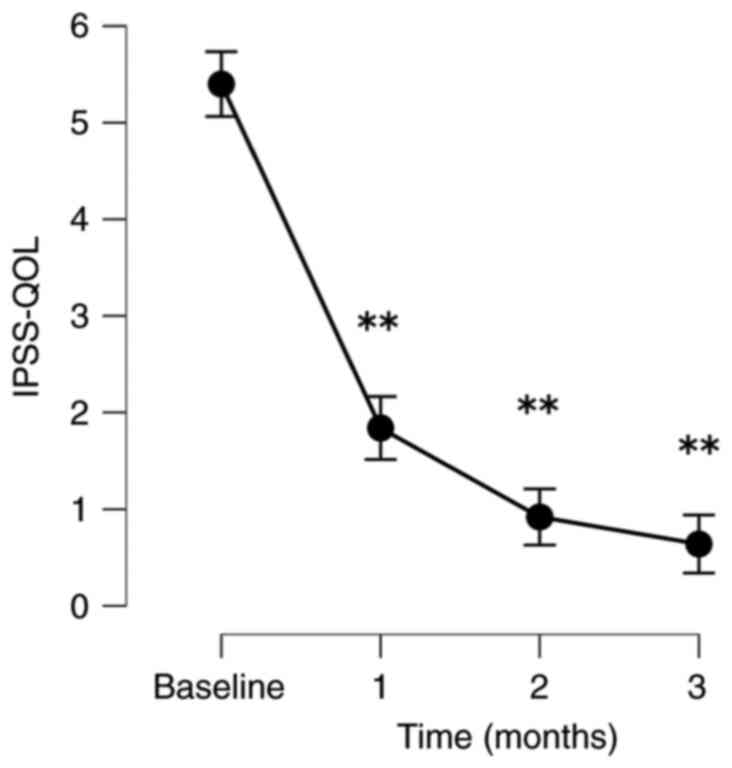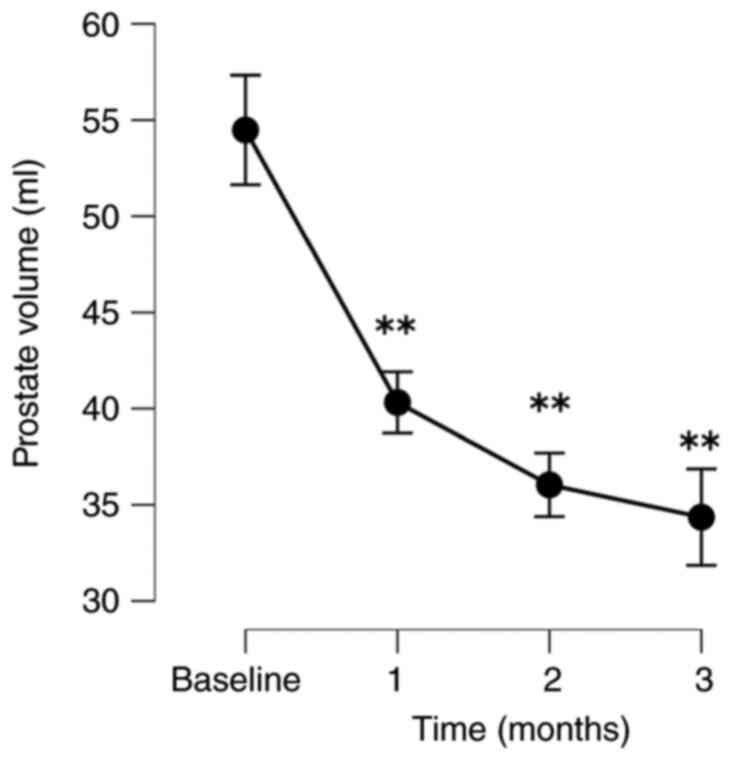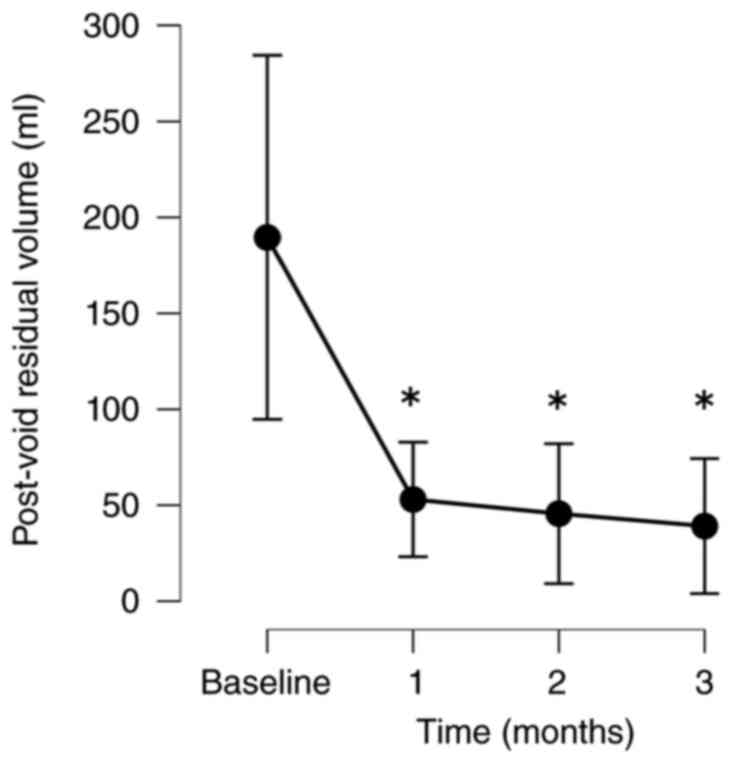|
1
|
Vuichoud C and Loughlin KR: Benign
prostatic hyperplasia: Epidemiology, economics and evaluation. Can
J Urol. 22 (Suppl 1):S1–S6. 2015.PubMed/NCBI
|
|
2
|
Wei JT, Calhoun E and Jacobsen SJ:
Urologic diseases in America project: Benign prostatic hyperplasia.
J Urol. 173:1256–1261. 2005.PubMed/NCBI View Article : Google Scholar
|
|
3
|
Zhang SJ, Qian HN, Zhao Y, Sun K, Wang HQ,
Liang GQ, Li FH and Li Z: Relationship between age and prostate
size. Asian J Androl. 15:116–120. 2013.PubMed/NCBI View Article : Google Scholar
|
|
4
|
Foster HE, Dahm P, Kohler TS, Lerner LB,
Parsons JK, Wilt TJ and McVary KT: Surgical Management of lower
urinary tract symptoms attributed to benign prostatic hyperplasia:
AUA guideline amendment 2019. J Urol. 202:592–598. 2019.PubMed/NCBI View Article : Google Scholar
|
|
5
|
Friedl A, Schneeweiss J, Stangl K,
Mühlstädt S, Zachoval R, Hruby S, Gründler T, Kivaranovic D,
Fornara P, Lusuardi L and Brössner C: The adjustable transobturator
male system in stress urinary incontinence after transurethral
resection of the prostate. Urology. 109:184–189. 2017.PubMed/NCBI View Article : Google Scholar
|
|
6
|
Brassetti A, DE Nunzio C, Delongchamps NB,
Fiori C, Porpiglia F and Tubaro A: Green light vaporization of the
prostate: Is it an adult technique? Minerva Urol Nefrol.
69:109–118. 2017.PubMed/NCBI View Article : Google Scholar
|
|
7
|
Checcucci E, Veccia A, De Cillis S,
Piramide F, Volpi G, Amparore D, Pecoraro A, Piana A, Granato S,
Verri P, et al: New ultra-minimally invasive surgical treatment for
benign prostatic hyperplasia: A systematic review and analysis of
comparative outcomes. Eur Urol Open Sci. 33:28–41. 2021.PubMed/NCBI View Article : Google Scholar
|
|
8
|
Jones P, Rai BP, Nair R and Somani BK:
Current status of prostate artery embolization for lower urinary
tract symptoms: Review of world literature. Urology. 86:676–681.
2015.PubMed/NCBI View Article : Google Scholar
|
|
9
|
Jones P, Rajkumar GN, Rai BP, Aboumarzouk
OM, Cleaveland P, Srirangam SJ and Somani BK: Medium-term Outcomes
of Urolift (Minimum 12 Months Follow-up): Evidence from a
systematic review. Urology. 97:20–24. 2016.PubMed/NCBI View Article : Google Scholar
|
|
10
|
Yilmaz M, Karaaslan M, Polat ME, Tonyali
S, Aybal HÇ, Şirin ME, Toprak T, Tunç L, Gratzke C and Miernik A:
Is day-case surgery feasible for laser endoscopic enucleation of
the prostate? A systematic review. World J Urol. 41:2949–2958.
2023.PubMed/NCBI View Article : Google Scholar
|
|
11
|
McVary KT, Gange SN, Gittelman MC,
Goldberg KA, Patel K, Shore ND, Levin RM, Rousseau M, Beahrs JR,
Kaminetsky J, et al: Minimally invasive prostate convective water
vapor energy ablation: A multicenter, randomized, controlled study
for the treatment of lower urinary tract symptoms secondary to
benign prostatic hyperplasia. J Urol. 195:1529–1538.
2016.PubMed/NCBI View Article : Google Scholar
|
|
12
|
McVary KT, Gittelman MC, Goldberg KA,
Patel K, Shore ND, Levin RM, Pliskin M, Beahrs JR, Prall D,
Kaminetsky J, et al: Final 5-year outcomes of the multicenter
randomized sham-controlled trial of a water vapor thermal therapy
for treatment of moderate to severe lower urinary tract symptoms
secondary to benign prostatic hyperplasia. J Urol. 206:715–724.
2021.PubMed/NCBI View Article : Google Scholar
|
|
13
|
Dixon CM, Cedano ER, Pacik D, Vit V, Varga
G, Wagrell L, Larson TR and Mynderse LA: Two-year results after
convective radiofrequency water vapor thermal therapy of
symptomatic benign prostatic hyperplasia. Res Rep Urol. 8:207–216.
2016.PubMed/NCBI View Article : Google Scholar
|
|
14
|
Dindo D, Demartines N and Clavien PA:
Classification of surgical complications: A new proposal with
evaluation in a cohort of 6336 patients and results of a survey.
Ann Surg. 240:205–213. 2004.PubMed/NCBI View Article : Google Scholar
|
|
15
|
Miller LE, Chughtai B, Dornbier RA and
McVary KT: Surgical reintervention rate after prostatic urethral
lift: Systematic review and meta-analysis involving over 2,000
patients. J Urol. 204:1019–1026. 2020.PubMed/NCBI View Article : Google Scholar
|
|
16
|
Sciacqua LV, Vanzulli A, Di Meo R,
Pellegrino G, Lavorato R, Vitale G and Carrafiello G: Minimally
invasive treatment in benign prostatic hyperplasia (BPH). Technol
Cancer Res Treat. 22(15330338231155000)2023.PubMed/NCBI View Article : Google Scholar
|
|
17
|
Yang J, Wu W, Amier Y, Li X, Wan W, Liu C,
Zhang Y and Yu X: Efficacy and safety of Water Vapor Thermal
Therapy in the treatment of benign prostate hyperplasia: A
systematic review and single-arm Meta-analysis. BMC Urol.
23(72)2023.PubMed/NCBI View Article : Google Scholar
|
|
18
|
Bole R, Gopalakrishna A, Kuang R, Alamiri
J, Yang DY, Helo S, Ziegelmann MJ and Köhler TS: Comparative
postoperative outcomes of rezūm prostate ablation in patients with
large versus small glands. J Endourol. 34:778–781. 2020.PubMed/NCBI View Article : Google Scholar
|
|
19
|
Johnston MJ, Noureldin M, Abdelmotagly Y,
Paramore L, Gehring T, Nedas TG, Rajkumar G, Emara A and Hindley
RG: Rezum water vapour therapy: Promising early outcomes from the
first UK series. BJU Int. 126:557–558. 2020.PubMed/NCBI View Article : Google Scholar
|
|
20
|
McVary KT, Holland B and Beahrs JR: Water
vapor thermal therapy to alleviate catheter-dependent urinary
retention secondary to benign prostatic hyperplasia. Prostate
Cancer Prostatic Dis. 23:303–308. 2020.PubMed/NCBI View Article : Google Scholar
|
|
21
|
Babar M, Loloi J, Azhar U, Tang K, Ines M,
Singh S, Iqbal N and Ciatto M: Rezum outcomes in relationship to
number of injections: Is less more? J Endourol. 37:157–164.
2023.PubMed/NCBI View Article : Google Scholar
|
|
22
|
Bausch K, Zahiti L, Schrutt M, Wetterauer
C, Halbeisen FS, Ebbing J and Seifert HH: Water vapor thermal
therapy of lower urinary tract symptoms due to benign prostatic
obstruction: Efficacy and safety analysis of a real-world cohort of
211 patients. World J Urol. 41:1605–1612. 2023.PubMed/NCBI View Article : Google Scholar
|
|
23
|
Elterman D, Bhojani N, Vannabouathong C,
Chughtai B and Zorn KC: Rezūm therapy for ≥80-mL benign prostatic
enlargement: A large, multicentre cohort study. BJU Int.
130:522–527. 2022.PubMed/NCBI View Article : Google Scholar
|
|
24
|
Whiting D, Noureldin M, Abdelmotagly Y,
Johnston MJ, Brittain J, Rajkumar G, Emara A and Hindley R:
Real-world early outcomes and retreatment rates following water
vapour ablative therapy for symptomatic benign prostatic
hyperplasia. Eur Urol Open Sci. 39:72–78. 2022.PubMed/NCBI View Article : Google Scholar
|

















